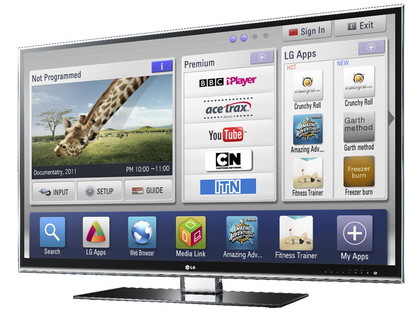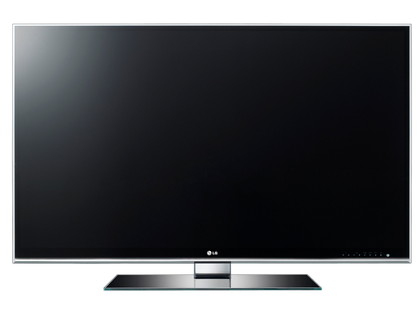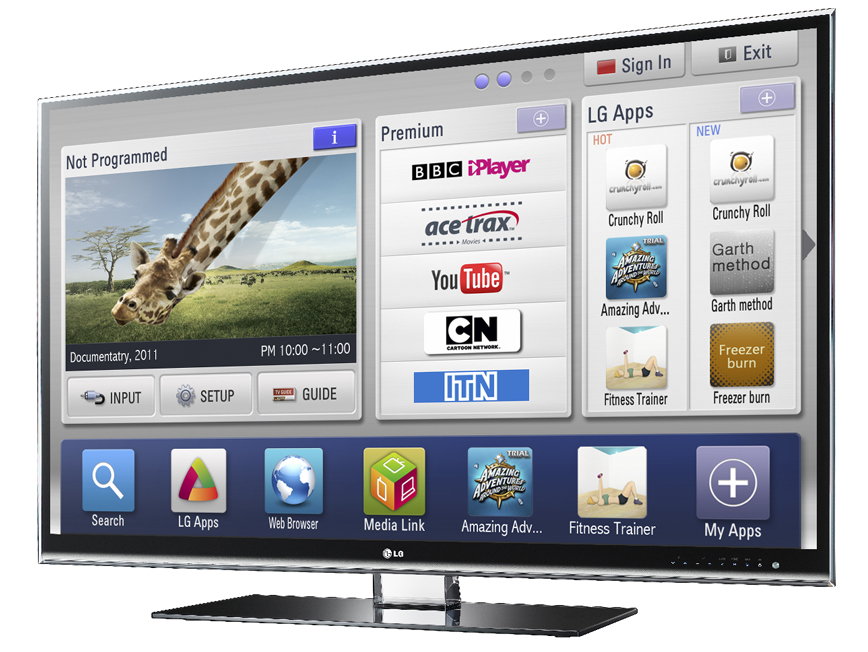Why you can trust TechRadar

So to the moment of truth: does the LG 55LW980T deliver on its direct-LED potential? For the most part actually yes, it does. But only if you set it up right.
The main reason we say this is that unless you're careful with some of the LG 55LW980T's settings, it can suffer some fairly serious contrast flaws.
When we first watched the LG 55LW980T, using its picture presets, dark scenes exhibited some positively crude levels of haloing around bright objects whenever they appeared against dark backgrounds.
This phenomenon is by no means uncommon with direct LED TVs when using local dimming, and is an artefact of the locally-controlled luminance areas in the panel not being able to control brightness accurately enough to stop there being a cloudy halo around bright objects. But this haloing issue is the worst we've seen on the LG 55LW980T.
Unless, that is, you turn the TV's LED local dimming tool either off or down to its Low setting from the mid level preferred by most presets. However, reducing the potency of the local dimming causes its own problems, sadly, as black level response takes a noticeable hit. Turn the local dimming off entirely and suddenly the image's black level response is really quite disappointing - far worse than you get with a half-decent plasma TV, and not really better, it seemed to us, than you might get from a good-quality edge LED TV.
Thankfully, there is a settings configuration that more or less works for the LG 55LW980T. What you need to do is have the LED dimming tool set to low, and the backlight set to between its 50 and 60 level. This allows the screen to deliver a perfectly credible black level without making the haloing a serious problem, or squeezing/crushing out of the picture too much shadow detail.
It's a shame that the LG 55LW980T provides so much flexibility with its contrast settings only to effectively force you to stick with one very specific setup mix, but there you go. At least you can get a satisfying result in the end, and that's all that really matters.
With this initial calibration hurdle settled, it's finally time to settle back and admire the rest of the LG 55LW980T's picture stall. And there really is an awful lot to admire.
For starters, 2D pictures still look extremely dynamic even with the local dimming engine only set to Low. Both bright and dark scenes look so multilayered, solid and vigorous that you almost feel as if you're watching 3D without any glasses on!
Colours are nothing short of gorgeous, too - especially when watching HD. They're extremely punchy and dynamic thanks to the way the local dimming engine permits the screen to be bright where it needs to be, even during dark scenes. But much more importantly, colours are also capable of looking both beautifully natural and extraordinarily subtly delineated, with not the faintest hint of a stripe of blotch (unless it's there in the source).
No sooner have you taken all this on board than something else about the LG 55LW980T's pictures hits you straight between the eyes: their awesome sharpness. HD sources are a joy to behold, with every last pixel of picture information rendered crisply and vigorously, right down to the finest grain that might be tucked away within a good Blu-ray film transfer.
What's more, this extraordinary detail intensity is achieved without the help of the entirely unnecessary Super Resolution system tucked away within the TV's menus. Nor does it seem forced to the extent that images look excessively fizzy, or the edges around bright objects look stressy.
Seeing so much HD detail in such a natural - and stable - way is a trick that never gets old. Especially as the set delivers more shadow detail than you would ever get with an edge or CCFL-lit LCD TV, and you're seeing it all in the gloriously large setting of a 55-inch screen.
Crucial to the extreme sharpness just described is another startling LG 55LW980T strength: its motion handling. There's practically no motion blur or judder at all, even with LG's TruMotion processing turned completely off.

This makes the LG 55LW980T the best LCD TV LG has ever produced where motion is concerned. In fact, the naturalism and clarity of the LG 55LW980T's motion reproduction is in some ways its most 'premium' achievement if you're looking for key reasons why you feel so directly connected and immersed in what you're watching.
Overall, once you've overcome the contrast issues noted earlier, the LG 55LW980T's HD 2D pictures are little short of sensational. And thankfully a surprising amount of quality remains when you switch to 2D.
The upscaling engine LG has used appears to be a level or two cleverer than the brand's usual efforts, resulting in standard definition images that look remarkably clean, believably coloured and reasonably sharp. There are TVs around that make standard definition look sharper, but this extra sharpness usually comes at the expense of noise. So the balance that LG has struck seems eminently sensible. And in any case, the LG 55LW980T does have the tools to ramp up the standard definition sharpness if you really want it to.
Before getting into the LG 55LW980T's 3D performance, there are a couple more little problems with the 2D pictures. First, the screen's glassy finish is rather reflective of any reasonably bright objects in your room.
Secondly, console gamers dreaming of playing their games on the LG 55LW980T should note that the screen's input lag measures around 60-65ms, using its gaming mode with picture processing turned off. This is actually much better than many other LG sets this year, but it's still much higher than the figures measured on most rival screens, and could definitely prove detrimental to a serious gamer's performance.
Things take an almighty upturn again, though, with the LG 55LW980T's 3D performance. In fact, in many ways its 3D images are a revelation, delivering the most persuasive argument yet in favour of LG's passive 3D technology.
This actually comes as something of a surprise, truth be told. Another 55-inch passive TV, the LG 55LW650T, underlined the weaknesses with the passive 3D format rather than its strengths. But while these weaknesses are still there on the LG 55LW980T, they seem much less dominant, allowing the passive advantages more room to shine.
Let's get the problems out of the way first. The most troubling one is the visible appearance of the 3D filter on the screen over certain areas of 3D pictures. This can manifest itself as very slight dark horizontal lines over bright parts of the picture. Or it can appear as short horizontal lines over very bright edges (meaning they can look slightly jagged) or small bright objects.
The impact of this visible filter structure diminishes with every foot you move away from the screen. But it's certainly visible from the 2.5-3m range that seemed the most comfortable viewing distance during this test.
Another issue with current passive 3D technology is that crosstalk (double ghosting noise) goes through the roof if you have to watch the TV from an angle of more than around 12 degrees above or below the screen. Also, even if you're watching from the perfect position, there's evidence of slight soft light leakage around some very bright objects, such as the white body of Maximus the horse in Tangled.
It's apparent on the LG 55LW980T that there is a reduction in resolution from the Full HD 3D pictures obtained from a 3D Blu-ray player. But for some reason - possibly/probably the extra quality of this TV's core picture technology - the impact of this latter issue isn't nearly as noticeable as it was on the 55LW650T.
In fact, 3D Blu-ray pictures look engagingly detailed and - mostly - sharp on the LG 55LW980T. Sure, there's a mite less detail and texture in skin tones, hair, grass and other areas of extreme detail than you might get with an active 3D screen, but the difference is less pronounced than expected - especially because the extra brightness of the passive 3D picture helps drive detailing out with more impact.
The LG 55LW980T emphasises even more than the 55LW650T passive 3D's advantage in brightness. Donning one of the free pairs of glasses the TV set ships with reduces brightness and colour saturation by only a fraction of the amount that active glasses do, overcoming one of the most common arguments against watching 3D at home.
There's also no flickering with the LG 55LW980T's 3D approach, and only minor amounts of crosstalk noise (so long as you avoid the viewing angle issue noted earlier). Also, overall the passive 3D experience feels less fatiguing than the active one.
The visible filter and loss of resolution issues will still make active 3D a potentially more appealing solution to AV enthusiasts. But it's a close-run thing, and we'd advise even a die-hard resolution lover to at least spend a little audition time with an LG 55LW980T before parting with any money.
John has been writing about home entertainment technology for more than two decades - an especially impressive feat considering he still claims to only be 35 years old (yeah, right). In that time he’s reviewed hundreds if not thousands of TVs, projectors and speakers, and spent frankly far too long sitting by himself in a dark room.

